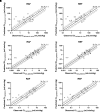In Vivo-to-In Vitro Extrapolation of Transporter-Mediated Renal Clearance: Relative Expression Factor Versus Relative Activity Factor Approach
- PMID: 33824168
- PMCID: PMC8232064
- DOI: 10.1124/dmd.121.000367
In Vivo-to-In Vitro Extrapolation of Transporter-Mediated Renal Clearance: Relative Expression Factor Versus Relative Activity Factor Approach
Erratum in
-
Correction to "In Vivo-to-in Vitro Extrapolation of Transporter-Mediated Renal Clearance: Relative Expression Factor Versus Relative Activity Factor Approach".Drug Metab Dispos. 2021 Sep;49(9):869. doi: 10.1124/dmd.121.000367err. Drug Metab Dispos. 2021. PMID: 34580152 Free PMC article. No abstract available.
Abstract
About 30% of approved drugs are cleared predominantly by renal clearance (CLr). Of these, many are secreted by transporters. For these drugs, in vitro-to-in vivo extrapolation of transporter-mediated renal secretory clearance (CLsec,plasma) is important to prospectively predict their renal clearance and to assess the impact of drug-drug interactions and pharmacogenetics on their pharmacokinetics. Here we compared the ability of the relative expression factor (REF) and the relative activity factor (RAF) approaches to quantitatively predict the in vivo CLsec,plasma of 26 organic anion transporter (OAT) substrates assuming that OAT-mediated uptake is the rate-determining step in the CLsec,plasma of the drugs. The REF approach requires protein quantification of each transporter in the tissue (e.g., kidney) and transporter-expressing cells, whereas the RAF approach requires the use of a transporter-selective probe substrate (both in vitro and in vivo) for each transporter of interest. For the REF approach, 50% and 69% of the CLsec,plasma predictions were within 2- and 3-fold of the observed values, respectively; the corresponding values for the RAF approach were 65% and 81%. We found no significant difference between the two approaches in their predictive capability (as measured by accuracy and bias) of the CLsec,plasma or CLr of OAT drugs. We recommend that the REF and RAF approaches can be used interchangeably to predict OAT-mediated CLsec,plasma Further research is warranted to evaluate the ability of the REF or RAF approach to predict CLsec,plasma of drugs when uptake is not the rate-determining step. SIGNIFICANCE STATEMENT: This is the first direct comparison of the relative expression factor (REF) and relative activity factor (RAF) approaches to predict transporter-mediated renal clearance (CLr). The RAF, but not REF, approach requires transporter-selective probes and that the basolateral uptake is the rate-determining step in the CLr of drugs. Given that there is no difference in predictive capability of the REF and RAF approach for organic anion transporter-mediated CLr, the REF approach should be explored further to assess its ability to predict CLr when basolateral uptake is not the sole rate-determining step.
Copyright © 2021 by The American Society for Pharmacology and Experimental Therapeutics.
Figures





References
-
- Al-Jahdari WS, Yamamoto K, Hiraoka H, Nakamura K, GotoF, and , Horiuchi R(2006) Prediction of total propofol clearance based on enzyme activities in microsomes from human kidney and liver. Eur J Clin Pharmacol 62:527–533. - PubMed
-
- Bouchet LG, Bolch WE, Blanco HP, Wessels BW, Siegel JA, Rajon DA, Clairand I, Sgouros G (2003) MIRD Pamphlet No 19: absorbed fractions and radionuclide S values for six age-dependent multiregion models of the kidney. J Nucl Med 44:1113–1147. - PubMed
-
- Chu X, Bleasby K, Evers R (2013) Species differences in drug transporters and implications for translating preclinical findings to humans. Expert Opin Drug Metab Toxicol 9:237–252. - PubMed
-
- Cooper AR, Forbes RM, Mitchell HH (1956) Further studies on the gross composition and mineral elements of the adult human body. J Biol Chem 223:969–975. - PubMed
-
- Feng B, LaPerle JL, Chang G, Varma MV (2010) Renal clearance in drug discovery and development: molecular descriptors, drug transporters and disease state. Expert Opin Drug Metab Toxicol 6:939–952. - PubMed
Publication types
MeSH terms
Substances
Grants and funding
LinkOut - more resources
Full Text Sources
Other Literature Sources
Medical
Research Materials
Miscellaneous

